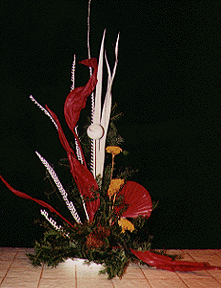|
Rittners School Of Floral Design
In Boston Presents....
 Contemporary Contemporary
Winter Design
We normally associate the winter holiday season with traditions, and therefore with traditional designing. But there is no rule that prohibits contemporary expression.
Sometimes when we play with combinations of traditional symbols and materials in new and different configurations we can get results that are startling, yet quite interesting.
In this design we are deliberately manipulating these variables. The red and the green found in the dried materials, balsam and glass balls bring to mind the traditional holiday colors. The red symbolizes the sun warming up the green earth after a long, cold and dark winter. (To our European ancestors, this was quite critical, for civilization could not exist if agriculture came to a total halt due to a permanent deep freeze). Yet, The traditional colors are contrasted with the addition of white and earth tones.
The materials are quite varied and the mixture unusual. We of course, associate the winter season with the use of such things as balsam, glass balls, and cones. In this design, however, we are not only using these items, but mixing them with unusual dried materials such as dried strelitzia leaves, bell cups and rib cycas.
The overall result is a design that has both familiar and unfamiliar aspects to it.
We feel comfortable with the familiar colors and materials, and yet are intrigued with the combinations that feel novel to us. That is what contemporary floral art is all about!!
What You Will Need
Container
Balsam
foam
Cones
Glass MM. Balls
Sabel palm
Rib cycas
Dried strelitzia leaves
Bell cups
Yarrow
Cut Palmetto leaf
Artificial foliage
Miniture carnations

Place foam into your container. Create a triangle using balsam foliage. Extend the overall dimensions of your design using dried materials. White sabel palm and five stems of rib cycas (towards the left) create greater height and provide contrast to the darker foliage.
Add three red dried strelitzia leaves towards the left side of the design. One is placed down on the baseline towards the right. Dried strelitzia is always an interesting choice. No two pieces are alike, and yes, it is actually the foliage of the bird of paradise flower!! When strelitzia foliage dries, it curls and twists. No two pieces are identical. The texture is really interesting, and the folks who distribute it dye it a wide variety of colors.
Add a single stem of red cut palmetto to the right side of the design for balance. Three yarrow are also placed into the right side of the design. A single white round bell cup is placed in the center part of the arrangement about a foot from the base.
Add a little sheet moss at the base of the design to cover any mechanics that haven't been covered by the balsam.

Continue adding white round bell cups extending four in total from the upper middle of the arrangement right down towards the base.
There is a rather large empty void at the baseline of the design, and so let's fill it in. A small cluster of white artificial foliage is picked into the bottom left side of the foam. This is followed by a few cones to which heavy florist wire has been attached. Finally two clusters of glass ornamental balls are placed, one to the left, the other to the right. We could consider the design completed at this point, a lovely blend of live balsam and assorted dried materials.

Although we could have stopped the design in the previous step, let's show you how we could continue to include materials in this design for even greater value.
Notice how the addition of a bunch of miniature carnations creates an even more full look to the design. It also provides the natural beauty that comes when flowers are incorporated. Other alternatives in place of miniature carnations could include: roses, sweetheart roses, & button poms. Another option would be to use artificial foliage, and include silk flowers.
We hope that you really enjoyed this brief floral design lesson. At
Rittners School of Floral Design
in Boston we provide floral design instruction that includes a wide range of different styles and techniques. Please come and take one of our hands-on workshop programs!!
Rittners Floral Education Center returns you to our Floral Education Center.
Your Webmaster is Dr. Steve Rittner, who may be reached at Stevrt@tiac.net.
All photographs and text on this page are Copyright - Rittners School,
and may not be reproduced, or used for any commercial purposes.
|